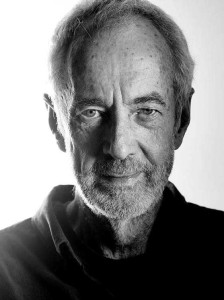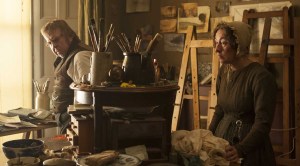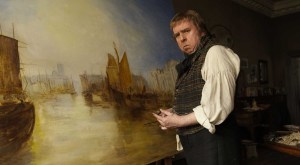
In his latest movie Mr. Turner, British director Mike Leigh immerses audiences in the early 19th century world of J.M.W. Turner. Turner is considered to be one of England’s greatest artists as well as the precursor of Impressionism, and is known as “the painter of light.” (His final deathbed utterance: “The Sun is God.”) Painterly, light-filled and ravishing, the cinematography of Dick Pope, the film’s director of photography, is appropriately anchored in the distinctive color schemes, subject matter and illumination used by the artist.
“Turner’s palette, that really was my starting point,” noted the DP who has now collaborated with Leigh on a dozen films. “I discovered through research that he used warm yellow in his highlights and blue-green, really teal, in his shadow areas. They were his two main complementary colors. I took these and applied them to the coloration of the film. That was the key for me.”
The ambitious movie’s gestation period stretched over a span of some 10 years, back to when Leigh first became intrigued with making a film about Turner, the grunting, wheezing real life genius of the later years that Timothy Spall brilliantly portrays. Pope dipped in and out of the project, doing research when he wasn’t shooting another movie. “My prep in downtime was spent absorbing Turner’s work, seeing his exhibitions, reading books about him and revisiting over and over Tate Britain’s permanent collection.” The Tate has the world’s largest collection of Turner paintings, thanks to his generous bequest to the nation of all the many masterpieces still in his possession when he died.

Pope always does a lot of careful testing of color and light at different locations before he embarks on a shoot. He only got down to serious prep, discovering the precise hues of Turner’s palette which he would try to emulate in the film, a short time before Leigh began his lengthy sui generis rehearsal process where the actors’ initial improvisations slowly evolve into a locked-down final script. “Mike always likes to be armed with the knowledge of what the film is going to look like when he goes into rehearsal period,” he noted.
As the rehearsals began, the DP went off to shoot another film in New York, Angelica, set in Victorian London. It was the first time he had shot a film with a digital camera. “That movie was the best prep I could have had—I used an Arri Alexa, and it’s a period film set in the late 1800s, with similar lighting techniques to what I used on Mike’s film,” he said.
The decision to go digital on Mr. Turner was less about choice than circumstance– the closing of film labs in England by companies like Technicolor, Deluxe and Fuji. “All around us the celluloid infrastructure was collapsing and we would have been in terrible trouble shooting Mr. Turner when we did,” observed Pope.
 Nonetheless, Pope avidly embraced the new format, and wound up using not one but two digital cameras, the Alexa and the Arri RAW for unique capabilities. The latter has a much wider latitude that lets it excel in robustly capturing images in minimal light. At the same time he chose to go with old-fashioned Cooke Speed Panchro lenses to soften the digital look. Panchros were ubiquitous in the 1940s and 1950s, used on films like Spartacus and so many others, and were on the camera that accompanied Sir Edward Hillary on his historic first ascent of Mt. Everest.
Nonetheless, Pope avidly embraced the new format, and wound up using not one but two digital cameras, the Alexa and the Arri RAW for unique capabilities. The latter has a much wider latitude that lets it excel in robustly capturing images in minimal light. At the same time he chose to go with old-fashioned Cooke Speed Panchro lenses to soften the digital look. Panchros were ubiquitous in the 1940s and 1950s, used on films like Spartacus and so many others, and were on the camera that accompanied Sir Edward Hillary on his historic first ascent of Mt. Everest.
“In the end the film looked neither like celluloid or digital,” the DP declared, somewhat bemused by his mixing of old and new technologies to achieve what he wanted. “Here I am using the digital state-of-the-art Alexa and the Arri RAW which give you the maximum detail in the image, the maximum latitude, the maximum range and I’m combining it with antique lenses that break down all that sharpness and give me the look of a period film,” he observed.
Clinging to shooting on film by some directors and cinematographers he believes is “more about nostalgia, a way of harkening back to a more cinematic era,” he said. “But I don’t feel like that—we’ve got to look ahead like Turner looked ahead. In the film we see him interested in astronomy, science, prismatic color and even photography—the future. So why do we have to be retrospective in terms of using celluloid?”
Aside from equipment issues, what mattered most to Pope—and also Leigh—was camera placement and framing. “The important thing is where we put the camera–Mike and I collaborate very closely on camera placement; that’s what we mostly do together, talk about how to shoot a scene, from what vantage point and whose point of view.” A lot of shots in the film are across the shoulder of Turner. “We’re looking down at him as he’s looking out, watching and observing,” noted the DP. “That was a conscious decision, to be looking at his world with him in it. The film is like a walk through his paintings with him caught up in the landscape.”
Many of the most gorgeous scenes were shot outdoors, in and around Margate, a seaside town on a peninsula in Kent, where Turner often painted because of the special quality of the light there. And the shoot was blessed with almost perfect weather, featuring the kind of light Turner sought out.
However, about two-thirds of the film was shot indoors, in Turner’s ramshackle house and studio, along with other interiors. While the lighting is unforced and naturalistic, Pope didn’t depend on available light. “All of the lighting in the interiors was my own,” he noted. “You can’t rely on natural light all the time. The way I work is to give a natural believable feel that’s a kind of heightened realism. That’s what I went for, to make the light interesting, to evoke the world through his eyes trying to see what drove him to painting in the first place.”
“If my work has a signature on it, it’s about quiet photography, under-the-table cinematography,” said Pope. “In a way that’s how Mike and I really hit off in the first place—he recognized me as a fellow traveler in this approach.”
Other films Pope has done with Leigh include Life is Sweet, Happy Go Lucky, Topsy-Turvy and Vera Drake. He twice won the prestigious award handed out to cinematographers by their peers, Camerimage (the International Festival for the Art of Cinematography), for Secrets and Lies in 1996 and Vera Drake in 2004. He received an Oscar nomination for best cinematography for The Illusionist. His next project is Legend directed by Brian Helgaland, set for release in 2015, about the Kray Brothers, gangsters who terrorized England in the 1950s and 1960s.





